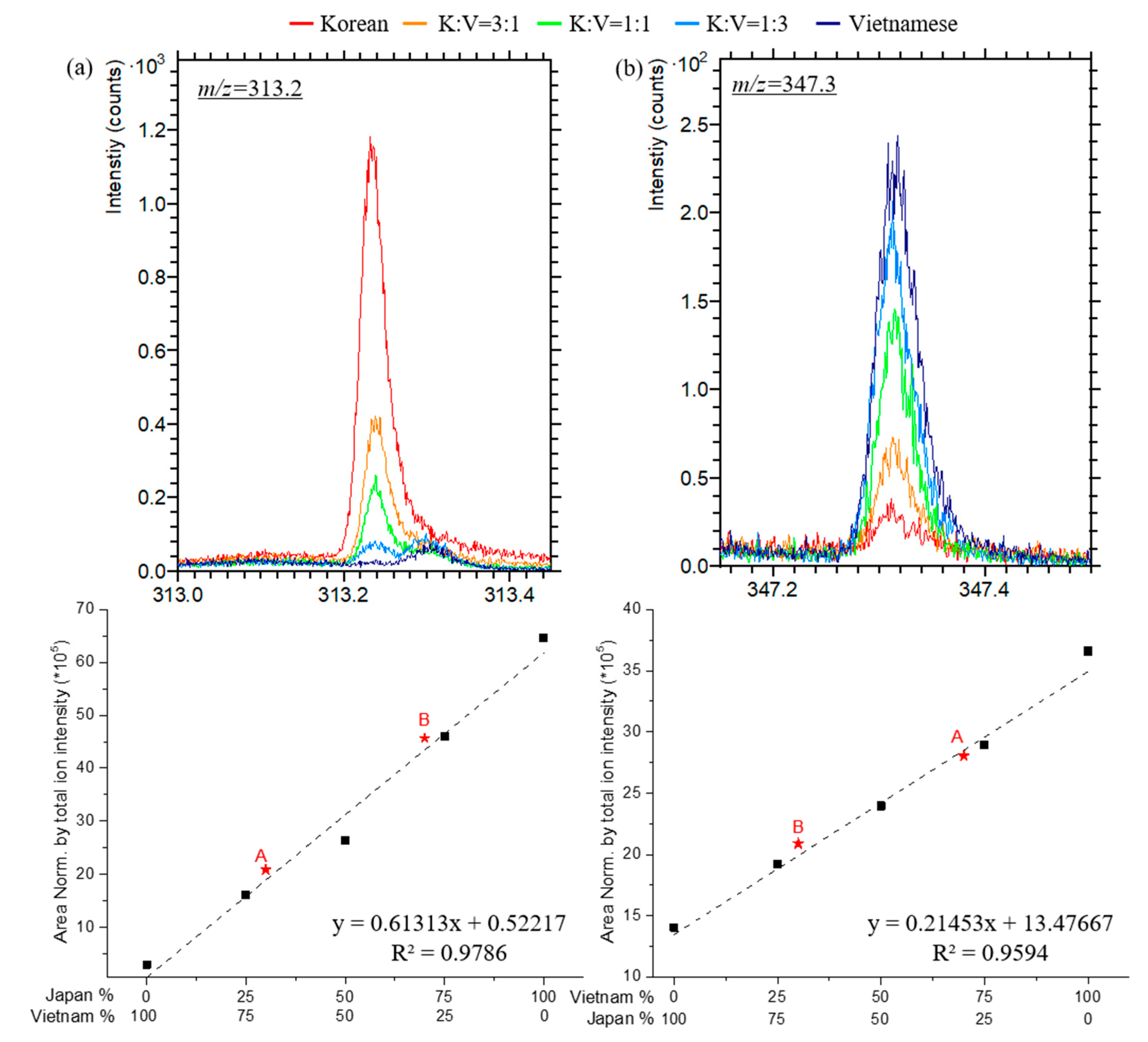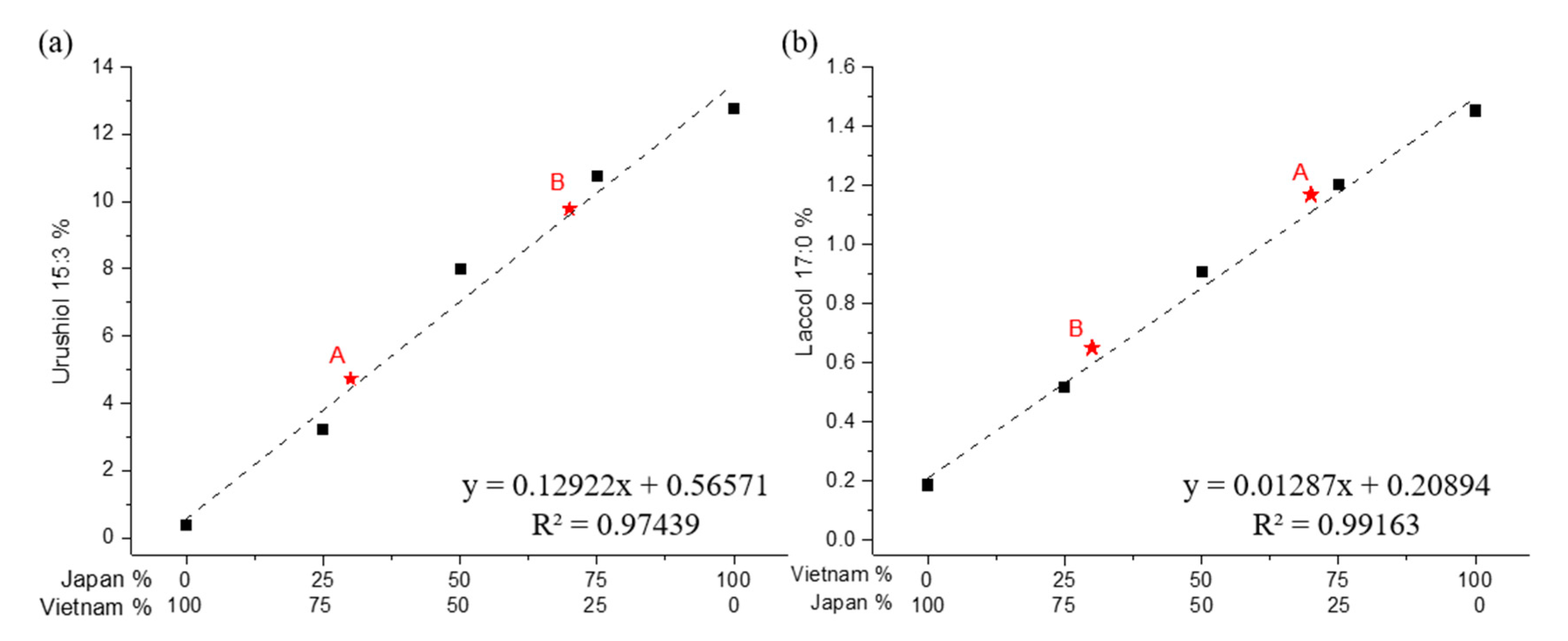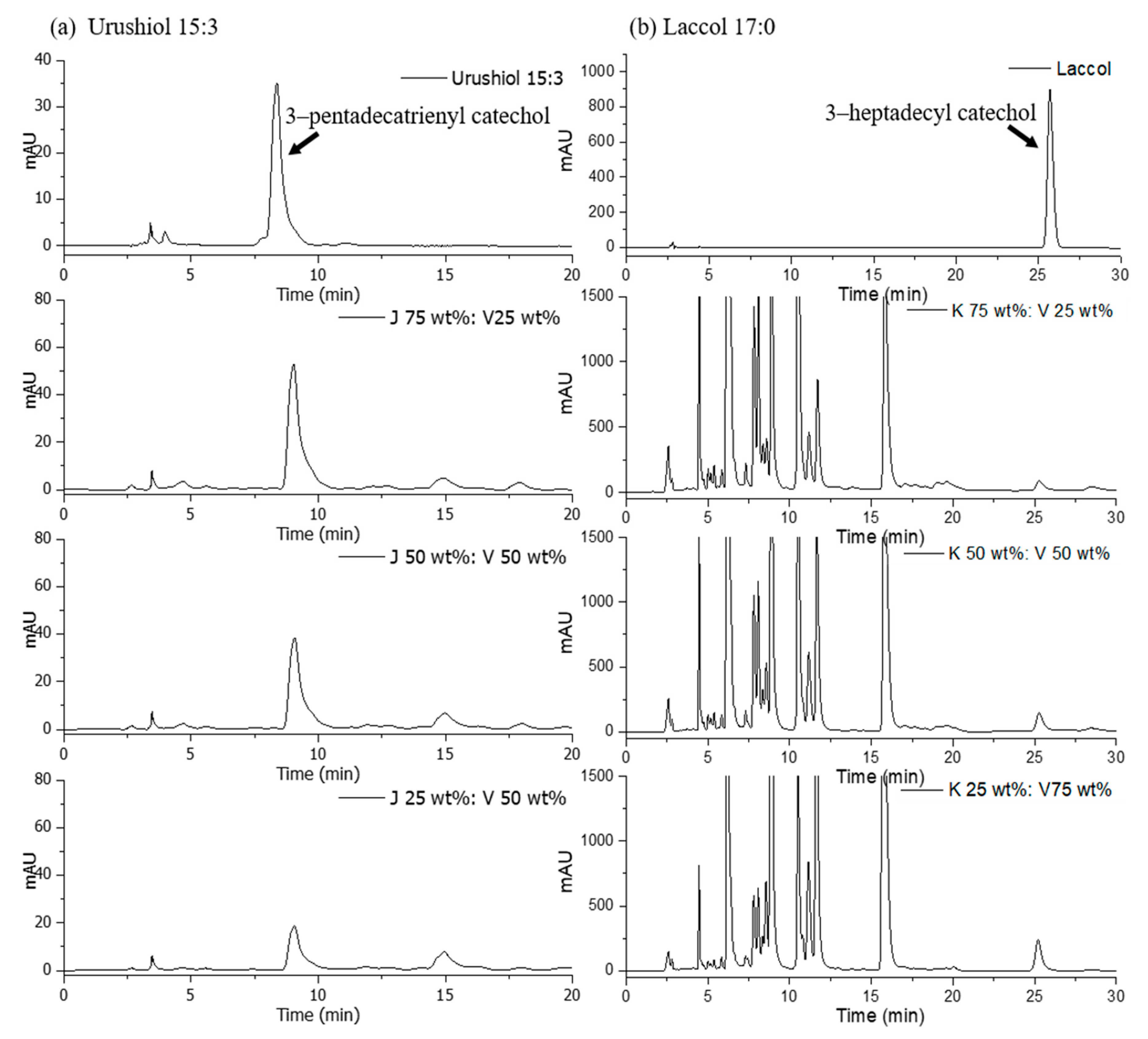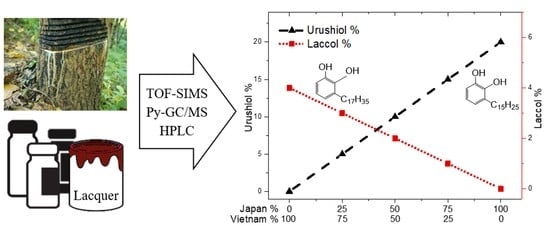Quantitative Analysis of Blended Asian Lacquers Using ToF–SIMS, Py–GC/MS and HPLC
Abstract
:1. Introduction
2. Materials and Methods
2.1. Materials
2.2. Instrumentation
3. Results and Discussion
3.1. ToF–SIMS
3.2. Py–GC/MS
3.3. HPLC
3.4. Blind Analysis of Unknown Blended Lacquers
4. Conclusions
Supplementary Materials
Author Contributions
Funding
Institutional Review Board Statement
Informed Consent Statement
Data Availability Statement
Conflicts of Interest
References
- Miyakoshi, T.; Nagase, K.; Yoshida, T. Process of Lacquer Chemistry; IPC: Tokyo, Japan, 1999. [Google Scholar]
- Webb, M. Lacquer: Technology and Conservation; Butterworth-Heinemann: Oxford, UK, 2000. [Google Scholar]
- Lu, R.; Miyakoshi, T. Lacquer Chemistry and Applications; Elsevier: Amsterdam, The Netherlands, 2015. [Google Scholar]
- Lu, R.; Yoshida, T.; Miyakoshi, T. Oriental lacquer: A natural polymer. Polym. Rev. 2013, 53, 153–191. [Google Scholar]
- Honda, T.; Lu, R.; Kamiya, Y.; Nakai, S.; Miyakoshi, T. Identification of Ryukyu lacquerwares by pyrolysis-gas chromatography/mass spectrometry and 87Sr/86Sr isotope ratio. J. Anal. Appl. Pyrolysis 2016, 117, 25–29. [Google Scholar]
- Sung, M.; Honda, T.; Lu, R.; Jung, J.; Miyakoshi, T. Investigation and analysis of Ryukyu lacquerwares decorated with wisteria vine by pyrolysis GC/MS and 87Sr/86Sr isotope ratio. Surf. Interface Anal. 2017, 49, 822–827. [Google Scholar]
- Sung, M.; Jung, J.; Lu, R.; Miyakoshi, T. Study of historical Chinese lacquer culture and technology—Analysis of Chinese Qin-Han dynasty lacquerware. J. Cult. Herit. 2016, 21, 889–893. [Google Scholar]
- Takahashi, S.; Sung, M.; Honda, T.; Lu, R.; Jung, J.; Miyakoshi, T. Analysis of Japanese Jōmon period red lacquerwares by pyrolysis gas chromatography/mass spectrometry. J. Archaeol. Sci. Rep. 2018, 18, 85–89. [Google Scholar]
- Niimura, N. Determination of the type of lacquer on East Asian lacquer ware. Int. J. Mass Spectrom. 2009, 284, 93–97. [Google Scholar]
- Frade, J.C.; Riberio, M.I.; Graça, J.; Rodrigues, J. Applying pyrolysis-gas chromatography/mass spectrometry to the identification of oriental lacquers: Study of two lacquered shields. Anal. Bioanal. Chem. 2009, 395, 2167–2174. [Google Scholar]
- Le Hô, A.S.; Duhamel, C.; Daher, C.; Gurlet, L.B.; Paris, C.; Regert, M.; Sablier, M.; André, G.; Desroches, J.P.; Dumas, P. Alteration of Asian lacquer: In-depth insight using a physico-chemical multiscale approach. Analyst 2013, 138, 5685–5696. [Google Scholar]
- Niimura, N.; Miyakoshi, T. Characterization of natural resin films and identification of ancient coating. J. Mass Spectrom. Soc. Jpn. 2003, 51, 439–457. [Google Scholar]
- Kumanotani, J. Urushi (oriental lacquer)—A natural aesthetic durable and future-promising coating. Prog. Org. Coat. 1995, 26, 163–195. [Google Scholar]
- Snyder, D.M. An overview of oriental lacquer: Art and chemistry of the original high-tech coating. J. Chem. Educ. 1989, 66, 977–980. [Google Scholar]
- Qin, M.; Mitchell, J.D.; Vogl, O. Oriental lacquer. 10. The South East Asian Lacquer. J. Macromol. Sci. A 1996, A33, 1791. [Google Scholar]
- Wang, C.; Chen, H.; Zhou, H.; Li, W.; Lu, L.; Phuc, B.T. Investigation and development on processing of Vietnamese lacquer. Adv. Biol. Chem. 2014, 4, 79–85. [Google Scholar]
- Honda, T.; Lu, R.; Sakai, R.; Ishimura, T.; Miyakoshi, T. Characterization and comparison of Asian lacquer saps. Prog. Org. Coat. 2008, 61, 68–75. [Google Scholar]
- Lambert, J.B.; Frye, J.S.; Carriveau, G.W. The structure of oriental lacquer by solid state nuclear magnetic resonance spectroscopy. Archaeometry 1991, 33, 87–93. [Google Scholar]
- Le Hô, A.S.; Francke, I.F.; Thiphavong, C. Properties of polymer-composite used as fills of Asian lacquerware: Issues on restoration processes of lacquered objects from cultural heritage. Int. J. Polym. Sci. 2015, 729132. [Google Scholar]
- Wang, N.; Liu, J.; He, L.; Zhou, T.; Rong, B.; Wang, L.; Zhao, X. Characterization of Chinese lacquer in historical artwork by on-line methylation pyrolysis-gas chromatography/mass spectrometry. Anal. Lett. 2014, 47, 2488–2507. [Google Scholar]
- Lu, R.; Hariygaya, S.; Ishimura, T.; Nagase, K.; Miyakoshi, T. Development of a fast drying lacquer based on raw lacquer sap. Prog. Org. Coat. 2004, 51, 238–243. [Google Scholar]
- Frade, J.C.; Ribeiro, I.; Graça, J.; Vasconcelos, T.; Rodrigues, J. Chemotaxonomic application of Py-GC/MS: Identification of lacquer trees. J. Anal. Appl. Pyrolysis 2010, 89, 117–121. [Google Scholar]
- Tsukagoshi, M.; Kitahara, Y.; Takahashi, S.; Fujii, T. Pyrolysis analysis of Japanese lacquer films: Direct probe-Li+ ion attachment mass spectrometry versus pyrolysis/gas chromatography/mass spectrometry. J. Anal. Appl. Pyrolysis 2015, 95, 156–163. [Google Scholar]
- Tsukagoshi, M.; Kitahara, Y.; Takahashi, S.; Tsugoshi, T.; Fujii, T. Characterization of Japanese lacquer liquid and films by means of evolved gas analysis-ion attachment mass. Anal. Meth. 2011, 3, 1943–1947. [Google Scholar]
- Ma, X.-M.; Lu, R.; Miyakoshi, T. Application of pyrolysis gas chromatography/mass spectrometry in lacquer research: A review. Polymers 2014, 6, 132–144. [Google Scholar]
- Pitthard, V.; Wei, S.; Miklin-Kniefacz, S.; Stanek, S.; Griesser, M.; Schreiner, M. Scientific investigations of antique lacquers from a 17th-century Japanese ornamental cabinet. Archaeometry 2010, 52, 1044–1056. [Google Scholar]
- Le Hô, A.S.; Regert, M.; Marescot, O.; Duhamel, C.; Langlois, J.; Miyakoshi, T.; Genty, C.; Sablier, M. Molecular criteria for discriminating museum Asian lacquerware from different vegetal origins by pyrolysis gas chromatography/mass spectrometry. Anal. Chim. Acta 2012, 710, 9–16. [Google Scholar]
- Niimura, N.; Miyakoshi, T. Characterization of synthesized lacquer analogue films using x-ray photoelectron spectroscopy. Surf. Interface Anal. 2000, 29, 381–385. [Google Scholar]
- Niimura, N.; Iijima, Y.; Miyakoshi, T. Hardening process and surface structure of lacquer films studied by x-ray photoelectron spectroscopy. Surf. Interface Anal. 1996, 24, 237–242. [Google Scholar]
- Lee, J.; Doh, J.M.; Han, H.G.; Lee, K.B.; Lee, Y. Investigation of Asian lacquer films using ToF–SIMS and complementary analytical techniques. Surf. Interface Anal. 2017, 49, 479–487. [Google Scholar]
- Lee, J.; Jung, S.-B.; Terlier, T.; Lee, K.B.; Lee, Y. Molecular identification of Asian lacquers from different trees using Py-GC/MS and ToF-SIMS. Surf. Interface Anal. 2018, 50, 696–704. [Google Scholar]
- Yang, J.; Chen, N.; Zhu, J.; Cai, J.; Deng, J.; Pan, F.; Gao, L.; Jiang, Z.; Shen, F. Polymerization mechanism of natural lacquer sap with special phase structure. Sci. Rep. 2020, 10, 12867. [Google Scholar]
- Oshima, R.; Yamauchi, Y.; Watanabe, C.; Kumanotani, J. Enzymic oxidative coupling of urushiol in sap of the lac tree, Rhus vernicifera. J. Org. Chem. 1985, 50, 2613–2621. [Google Scholar]
- Sung, M.; Lu, R.; Miyakoshi, T.; Jung, J. Thermal polymerization mechanism of thitsiol separated from Gluta usitata. Int. J. Polym. Anal. Charact. 2017, 22, 408–414. [Google Scholar]






| Blend | Japanese (wt%) | Vietnamese (wt%) |
|---|---|---|
| JV01 | 100 | 0 |
| JV02 | 75 | 25 |
| JV03 | 50 | 50 |
| JV04 | 25 | 75 |
| JV05 | 0 | 100 |
| Unknown A | 30 | 70 |
| Unknown B | 70 | 30 |
| ToF–SIMS | - Primary ion: Bi3+ - Energy: 30 keV - Current: 0.6 pA - Analysis area: 100 μm × 100 μm - Polarity: Positive |
| Py-GC/MS | - Injection volume: 10 μL - Furnace: 500 °C; pyrolyzer interface: 300 °C - Oven temperature: 40 °C (2 min) to 320 °C (14 min) at 20 °C/min |
| HPLC, urushiol | - Column: C18 reverse-phase column YMC-Pack Pro C18, 250 × 4.6 mm I.D. S-5 µm, 12 nm - Mobile phase, 90:10 v/v: Eluent A: Acetonitrile 90% Eluent B: Acqueous trifluoroactic acid, 0.1 vol% - Flow: 1 mL/min - Injection volume: 10 µL - Temperature: 30 °C - Detection: UV, 254 nm - Sample solvent: Chloroform |
| HPLC, laccol | - Column: C18 reverse-phase column YMC-Pack Pro C18, 250 × 4.6 mm I.D. S-5 µm, 12 nm - Mobile phase, 5:95 v/v: Eluent A: 0.1% THF in dilute water 5% Eluent B: Acetonitrile 95% - Flow: 1 mL/min - Injection volume: 10 µL - Temperature: 40 °C - Detection: UV, 210 nm - Sample solvent: methanol |
| 3-[(8E,11E)-pentadeca-8,11,14-trienyl] benzene-1,2-diol |  |
| 3-heptadecylbenzene-1,2-diol |  |
| ToF–SIMS | Py–GC/MS | HPLC | Used Contents | ||
| Jap.:Viet. | Jap.:Viet. | Jap.:Viet. | Jap.:Viet. | ||
| Based on Urushiol | Unknown A | 33.4:66.6 | 32.4:67.6 | 32.9:67.1 | 30.0:70.0 |
| Unknown B | 73.4:26.6 | 71.3:28.7 | 71.1:28.9 | 70.0:30.0 | |
| Based on Laccol | Unknown A | 34.6:65.4 | 25.2:74.8 | 33.9:66.1 | 30.0:70.0 |
| Unknown B | 66.1:33.9 | 65.9:34.1 | 71.2:28.8 | 70.0:30.0 | |
Publisher’s Note: MDPI stays neutral with regard to jurisdictional claims in published maps and institutional affiliations. |
© 2020 by the authors. Licensee MDPI, Basel, Switzerland. This article is an open access article distributed under the terms and conditions of the Creative Commons Attribution (CC BY) license (http://creativecommons.org/licenses/by/4.0/).
Share and Cite
Yu, H.H.; Lim, J.-A.; Ham, S.W.; Lee, K.-B.; Lee, Y. Quantitative Analysis of Blended Asian Lacquers Using ToF–SIMS, Py–GC/MS and HPLC. Polymers 2021, 13, 97. https://doi.org/10.3390/polym13010097
Yu HH, Lim J-A, Ham SW, Lee K-B, Lee Y. Quantitative Analysis of Blended Asian Lacquers Using ToF–SIMS, Py–GC/MS and HPLC. Polymers. 2021; 13(1):97. https://doi.org/10.3390/polym13010097
Chicago/Turabian StyleYu, Hye Hyun, Jung-Ah Lim, Seung Wook Ham, Kang-Bong Lee, and Yeonhee Lee. 2021. "Quantitative Analysis of Blended Asian Lacquers Using ToF–SIMS, Py–GC/MS and HPLC" Polymers 13, no. 1: 97. https://doi.org/10.3390/polym13010097
APA StyleYu, H. H., Lim, J.-A., Ham, S. W., Lee, K.-B., & Lee, Y. (2021). Quantitative Analysis of Blended Asian Lacquers Using ToF–SIMS, Py–GC/MS and HPLC. Polymers, 13(1), 97. https://doi.org/10.3390/polym13010097






